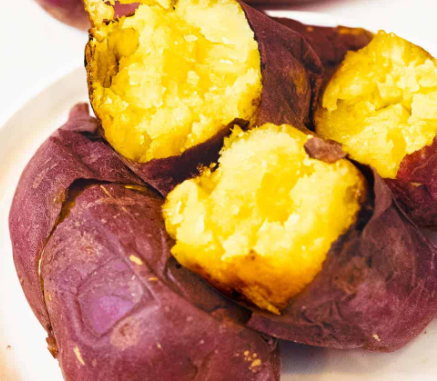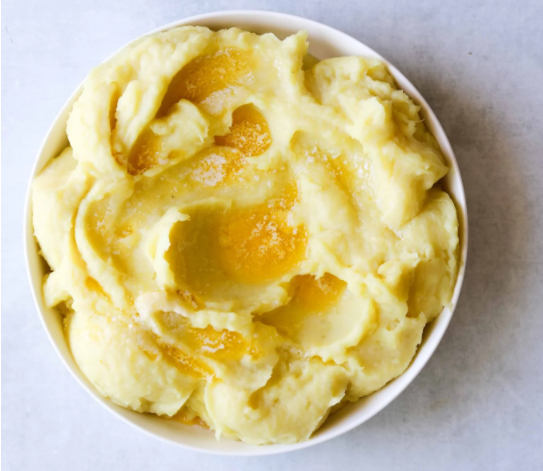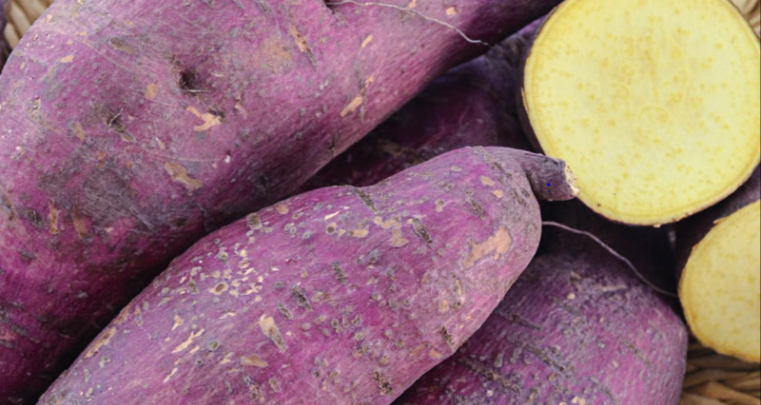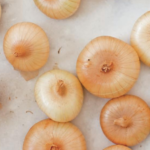Murasaki sweet potato is a dark-purple-skinned, white-fleshed elongated sweet potato cultivar. The sweet potato has a nutty-sweet flavor and a wide variety of culinary applications. Murasaki gets its name from the Japanese word for purple color – Murasaki. This purple sweet potato was developed to be disease resistant and to grow in Louisiana although it is now widely grown in California, United States.
Table of Contents
What is Murasaki Sweet Potato?
Murasaki sweet potato is a starchy root vegetable belonging to the species Ipomoea batatas. The plant family is bindweed or morning glory family also known as Convolvulaceae. Similar to other sweet potatoes, Murasaki root tubers develop belowground and are ready for harvest at about 130 days.
The sweet potato is recognizable by its dark-purple skin. However, depending on soil type, the skin color can range from a dark purple to a less intense purple, and this is not all. Whereas other purple sweet potatoes such as Oknawan and Stokes Purple have purple skin and purple flesh, Murasaki sweet potato has white to pale yellow flesh. In addition, unlike other white-fleshed sweet potatoes which have a neutral flavor, Murasaki has an intense nutty flavor with some sweetness.
Some growers prefer to cure the sweet potato for some 6 to 8 weeks by exposing the harvested root tubers to sunlight and open-air during the day. This gently coaxes the sweet potatoes to develop an enhanced sweet flavor.
Murasaki sweet potato has been likened to the Russet potato in its various culinary applications. Although it shines best when baked, it can also be, boiled, roasted, grilled, and even used in salads. Its starchy and very moist texture makes it a suitable candidate for baking.
Murasaki Sweet Potato Origin
Murasaki sweet potato originated in Louisiana, United States. Although often referred to as Japanese sweet potato, strictly speaking, Murasaki is not a Japanese sweet potato. What we have is just the use of a Japanese name and similarities to true Japanese sweet potatoes such as Kotobuki sweet potato out of Japan, for example.
Formally identified as Murasaki-29, the sweet potato was developed in 2001 by Louisiana Agricultural Experiment Station as an open-pollinated cultivar. The goal was to release a purple specialty sweet potato cultivar, an alternative to orange flesh varieties and offering resistance to southern root-knot nematode and soil rot sweet potato diseases. This sweet potato cultivar is patented in the United States under patent #USPP19955P2.
As much as it originated in Louisiana and was developed in Louisiana for Louisiana growing conditions, Murasaki-29 performed much better in California. Inconsistencies in shape, from egg-shaped to round and even splits, were observed under Louisiana growing conditions. However, the cultivar performed so well in California for the commercial market so as to compete with other white flesh sweet potato varieties.
Today, Murasaki is one of the most popular purple sweet potatoes available on the open market.
Murasaki Sweet Potato vs Purple Sweet Potato
Purple sweet potato is an umbrella name for a variety of purple sweet potatoes which include but are not limited to Murasaki sweet potato. Some well-known purple sweet potato names include Okinawan, Charleston, Stokes Purple, and Kotobuki. Kotobuki sweet potato, in particular, is more common in Japan than anywhere else in the world. As can be expected these sweet potato cultivars have different characteristics.
For example, Murasaki has purple skin and white flesh. On the other hand, other purple sweet potatoes such as Stokes Purple have purple skin and purple flesh. Furthermore, different purple sweet potatoes are best suited for use for certain culinary preparations better than others. For instance, Stokes Purple is good for making sweet potato pie, soups, and savory dishes. On the other hand, Murasaki sweet potato produces scrumptious baked recipes.
Depending on intended use, Murasaki may not always be the best sweet potato to use compared to other sweet potato choices available on the market. Moreover, as pertaining to health benefits, Murasaki has only the skin which is purple, whereas other varieties, as already mentioned, have both the skin and flesh which are purple. From this perspective, these other varieties have better health benefits compared to Murasaki sweet potato (see health benefits section).
Murasaki vs Japanese Sweet Potato
A comparison between Murasaki and Japanese sweet potatoes will reveal that although the two potato types have some differences, they have many similarities.
As earlier mentioned, as much as Murasaki is a Japanese name, the sweet potato itself was developed in the United States. Nevertheless, Murasaki resembles true Japanese sweet potatoes. For this reason, it is often simply called Japanese sweet potato in some circles.
Factually, true Japanese sweet potatoes have been cultivated in Japan for thousands of years. Kotobuki is an example of a Japanese sweet potato, as earlier stated. However, this cultivar varies from Murasaki in that it has purple skin and deep purple flesh whereas Murasaki has purple skin and white to yellowish flesh.
Japanese sweet potatoes such as Satsuma-imo have a much closer resemblance to Murasaki. Similar to Murasaki, they have a sweet and rich flavor. There are a handful of varieties of Satsuma-imo sweet potatoes. Examples include Beni-satsuma, Beni-haruka and Annou-imo. All of these are grown in Japan and are very popular in Japanese cuisine.
These are purple-skinned and yellowish flesh sweet potatoes almost similar to Murasaki sweet potato. These potatoes arrived in Japan from China some 1600 years ago. Furthermore, these true Japanese potatoes have almost similar culinary applications as the United States developed Murasaki sweet potatoes. They can be baked, roasted, or deep-fried among other delicious recipe applications.
Another point of similarity between Murasaki and Japanese sweet potatoes such as Beni-Kirishima is that just like Beni-Kirishima, Murasaki sweet potatoes can be coaxed to increase sweetness through extended storage after harvest.
Overall, if you are in the United States where exact Japanese sweet potatoes may not be accessible, most purple-skinned, white to yellowish fleshed (or purple-fleshed) sweet potatoes would pass for a Japanese sweet potato.
Murasaki vs Okinawan Sweet Potato
Although they are both purple sweet potatoes, juxtaposed, there are stark differences between Murasaki and Okinawan sweet potatoes. An apparent difference is in their appearance. While Murasaki has purple skin and white to yellowish flesh, Okinawan sweet potato has creamy-looking beige skin and purple-bluish flesh.
The sweet potatoes share their purple-ness in skin color and flesh color respectively. If one was considering which one between the two to pick on the basis of health benefits, Okinawan sweet potatoes look promising due to their antioxidant-rich purple flesh compared to purple Murasaki sweet potatoes which only have purple pigment in their skin.
Other Murasaki and Okinawan sweet potatoes differences are found in taste, texture, and uses. Okinawan sweet potato has some sweetness just like Murasaki sweet potato, however, the sweetness is mild with some notes of honey with a slightly bitter aftertaste. Murasaki is often described as having sweetness accompanied by notes of brown sugar and vanilla.
As earlier stated, Murasaki sweet potato is very starchy and at the same time moist, on the other hand, Okinawan sweet potatoes are also very starchy yet also dry. While Murasaki sweet potatoes shine best when used in baking, Okinawan sweet potatoes are best suited for making French fries and fried potato dishes.
Although now mostly associated with Hawaii and even called Hawaiian sweet potatoes, Okinawan sweet potatoes are originally Japanese sweet potatoes at least beginning in the 1600s. They only arrived in Hawaii much later where they now feature extensively as part of the local diet. On the other hand, as already mentioned, Murasaki sweet potatoes were developed just recently in the United States.
Overall, there are more differences than there are similarities when considering Murasaki vs Okinawan sweet potato.
Murasaki Sweet Potato vs Regular Sweet Potato
The main difference between Murasaki sweet potatoes and regular sweet potatoes is that Murasaki sweet potatoes are purple sweet potatoes. By regular sweet potatoes, we are referring to different sweet potato types which are not purple specialty types such as Murasaki.
While Murasaki has purple skin, regular sweet potatoes can be brown, yellow, orange, or red varieties. There are many regular sweet potato varieties. Apart from purple sweet potatoes with purple flesh, regular sweet potatoes can also have creamy white or vibrant orange flesh.
Whereas Murasaki is a purple sweet potato along with other purples such as Okinawan, Stokes purple, and Charleston sweet potatoes, there are also different types of regular sweet potatoes. These include Creamsicle, O’henry, Willowleaf, and Beauregard. Beauregard is one of the most widely grown regular sweet potato cultivars for commercial purposes.
Depending on the type, some regular sweet potatoes have just about similar applications as Murasaki sweet potatoes. For example, if you wanted regular sweet potatoes suitable for baking in the same way as Murasaki sweet potato, you would opt for sweet potatoes which are moist and very starchy. We have in mind here red or orange sweet potato varieties.
In respect of health benefits, Murasaki sweet potato having purple skin has more to offer health-wise than regular sweet potatoes with regular skin and regular flesh (see health benefits section).
Murasaki Sweet Potato vs Korean Sweet Potato
A comparison between Murasaki and Korean sweet potatoes will show that both are purple sweet potatoes with some very close similarities. In Korea sweet potatoes are known as Goguma. There are two specific types of Goguma which are purple sweet potatoes – Jeok-Goguma and Bam-Goguma.
Of the two, Bam-Goguma also known as Chestnut sweet potato is similar to Murasaki sweet potato. It has purple skin just like Murasaki and a similarly creamy yellow interior. The interior of the Chestnut sweet potato is lighter and fluffier. This Korean sweet potato is so popular in Korea, in most cases when people are talking about sweet potatoes they are simply referring to Bam-Goguma or the Chestnut sweet potato.
Compared to Murasaki sweet potato which has some sweetness and notes of brown sugar and vanilla, Chestnut sweet potato aka Korean sweet potato has a taste similar to chestnuts. Unlike Murasaki which is moist, Korean sweet potato is drier also similar to chestnuts. Just like Murasaki sweet potatoes, Korean sweet potatoes can also be baked. They are also used in recipes that involve deep-frying such as the Korean side dish mattang.
Overall, a recipe that calls for Korean sweet potatoes can easily be substituted with Murasaki sweet potatoes and vice versa.
Murasaki Sweet Potato Nutrition and Benefits
Purple sweet potatoes are not only nutritious but also have some additional functional purposes in human health. Concerning nutrition, Murasaki sweet potato, like many other sweet potatoes, has starches, vitamins, and minerals to offer in its storage roots. A 100 grams of sweet potato, for example, has 20 grams of carbs and 3 grams of fiber. Sweet potatoes such as Murasaki also contain vitamins A, C, B5, and B6 as well as vitamin E. They also have health-beneficial minerals namely potassium and magnesium.
While the nutritional value of Murasaki sweet potato is just about the same as other sweet potatoes, this sweet potato has a bit more health benefits to offer than regular sweet potatoes. The purple skin of Murasaki sweet potatoes contains antioxidants known as anthocyanins. Anthocyanins are naturally occurring chemical compounds that give the sweet potato skin its color. They also occur in other fruits and vegetables such as purple cabbage, purple lettuce, purple broccoli, purple tomatoes, beets, and red grapes.
Foods such as Murasaki sweet potato and purple sweet potatoes, in general, are often referred to as functional foods. Functional foods are foods that go beyond just nutrition but offer other superior health benefits. Anthocyanins found in purple sweet potatoes are responsible for the functional aspect of purple sweet potatoes.
According to the journal Food and Nutrition Research, anthocyanins are “antidiabetic, anticancer, anti-inflammatory, antimicrobial, and anti-obesity effects, as well as prevent cardiovascular diseases (CVDs)”. Regular sweet potatoes carry no such health benefits because they lack anthocyanins.
It can be stated that the purple color in Murasaki sweet potatoes is limited to the skin, whereas other sweet potatoes have purple flesh. These have an increased offering in anthocyanins. A good example is the Ayamurasaki, a Japanese sweet potato developed in Japan in the 1990s. Ayamurasaki and Okinawan have high levels of anthocyanins due to their purple flesh more than Murasaki or Korean sweet potatoes which only have purple skin.
As much as all sweet potatoes have nutritional value, if looking to eat purple sweet potatoes, particularly for their functional health benefits as explained above, there is more value in purple-fleshed sweet potatoes compared to those that only have purple skin such as Murasaki.
Murasaki Sweet Potato Recipes
As earlier stated, Murasaki sweet potatoes are best used as baking sweet potatoes due to their moisture and high starch texture. However, there are other things to be done using these sweet potatoes with scrumptious results. Below are some delicious recipes to try out that can be made using Murasaki sweet potatoes. You may also have a look at these general recipes with sweet potatoes.
Baked Murasaki Sweet Potato Recipe

There are two things to this recipe. The first one is that it calls for Korean sweet potatoes and the second is that it is a baking or roasting recipe. In both cases, this recipe perfectly fits the bill for Murasaki sweet potatoes. Although the recipe calls for Korean sweet potato, Murasaki is perfectly suited to substitute it (see comparison section above).
Furthermore, Murasaki sweet potato is also perfectly suited for the cooking method used in this recipe. The sweet potatoes will be baked whole. Some holes will be poked on the sweet potatoes to allow them to release steam when baking. When they are ready to serve they will be soft and fluffy with the skin wrinkled and very easy to separate from the flesh. View Recipe.
Delicious Murasaki Fries Recipe

Apart from baking, you could also make a variation of regular French using Murasaki sweet potatoes. There are two methods to this, you could use an air fryer or use the oven. Furthermore, the fries are open to a wide variety of seasonings that can be used at a time.
This is excellent because there is so much room to make them differently with a twist each time. For example, the fries can be seasoned with cumin, paprika, cayenne powder, onion powder, and garlic powder among others. Serve the final product with burgers, grilled meat, or even a green salad. Dips such as ketchup, BBQ sauce, and mustard will also go well with the fries. View Recipe.
Murasaki Sweet Potato Soup Recipe

This recipe produces a creamy vegan soup that serves six. Any Japanese sweet potato will do in this recipe which makes Murasaki well suited. The sweet potatoes are first peeled and then cubed. You could also consider cooking with the skin on after a thorough wash.
Other ingredients going into the recipe will be sushi rice (example), coconut milk, red curry paste, and toasted nori (example) among others. Once the soup is ready and put in bowls, some croutons can be used as toppings before immediately serving. View Recipe.
Whipped Japanese Sweet Potatoes Recipe

This recipe, once again, shows that there is more to do with Murasaki sweet potatoes than just baking. You can also make a scrumptious whipped dish using the sweet potato. The final product is an inviting very light, buttery, and slightly sweet and creamy-looking side dish.
You will need a potato ricer (example) in making this recipe. This kitchen tool produces much better results than a masher. The potatoes will be peeled and cut in quarters before use. The recipe will require a handful of other ingredients namely chicken stock, cream, and stick butter. It will take a total of 40 minutes to make and serves 6. View Recipe.
Growing Murasaki Sweet Potato
Growing Murasaki sweet potatoes is fairly straightforward and not a preserve of green thumbs. The sweet potatoes can be started from cuttings obtained from existing sweet potato runners, plant slips, or root tubers.
Propagating Murasaki Sweet Potatoes from Cuttings
Cuttings are considered the easiest and fastest way to get your Murasaki going. These can also be called unrooted plant slips (more below). From an existing plant, a 12 inch or 30cm runner is cut.
The section next to the cutting point on the removed runner is stripped of any leaves. Only a few leaves are left towards the opposite end or tip of the cutting. About 4 inches or 10cm of cutting is buried in the ground covered with soil. Roots will develop from the buried section at the leaf nodes.
Propagating Murasaki from Rooted Plant Slips
Another method of growing Murasaki sweet potatoes is by using rooted plant slips. Plant slips are rooted sweet potato cuttings. Instead of putting the cuttings directly and immediately in the ground, they are first left to sprout roots in soil or water before they are planted in the ground. This is a longer method than the first but produces similar results.
Nevertheless, this method is used by many home growers and large-scale sweet potato farmers. Each plant slip is put in a hole in the soil at 18 inches apart at about 6 inches deep. The hole is filled with soil. High nitrogen fertilizers should be avoided as this leads to prolific lush foliage above ground but little to no root tubers below ground.
Murasaki sweet potatoes will blossom after about two months following planting in the ground. The sweet potato produces white flowers with a purple inside. Harvesting of the sweet potatoes occurs at about 100 to 130 days after setting the slips in the ground.
If frost approaches before the harvest is completed, a good way of protecting the root tubers that remain below ground is to remove all the vines above ground. This stops the damage and stress caused by the frost from transmitting to the root tubers.
After harvest, to boost sweetness, Murasaki sweet potatoes can be cured for some 6 to 8 weeks by leaving them exposed to the sun and air during the day.
Growing Murasaki Sweet Potatoes from Root Tubers
One more method of propagating Murasaki sweet potatoes is through the root tubers themselves. Out of the earlier harvested sweet potatoes, the smaller ones are selected for planting. These are put in the ground at about the same spacing as plant slips and covered with soil. This method mimics growing regular potatoes.
The Murasaki sweet potato tubers will sprout and leaves appear above ground. They will start growing new runners just like the parent plant. Growing sweet potatoes like this offers lesser control as sprouts can shoot from any part of the root tuber, in many cases at multiple spots. Depending on grower preference, some thinning may be necessary to maintain good spacing.
There is certainly more to appreciate about growing sweet potatoes in general and not necessarily growing Murasaki sweet potatoes alone. In any case, growing Murasaki sweet potatoes, for the most part, is similar to growing a wide variety of other sweet potato types which may not necessarily be purple sweet potatoes. We thus recommend this article Growing Sweet Potatoes for detailed information on growing sweet potatoes.
Conclusion
Although not strictly the case, Murasaki sweet potato is sometimes called Japanese sweet potato as much as it was developed in the United States. In a similar fashion as Korean sweet potato substituting Japanese sweet potatoes in Korea, Murasaki has however come to perfectly substitute the true Japanese sweet potato in the United States because of its characteristics and wide availability. Murasaki is a nutritious functional purple sweet potato that is best suited for baking although it is used in a variety of other culinary applications. It is easy to grow and can be propagated in a similar manner as other regular sweet potatoes.
Random But Good Reads:-


